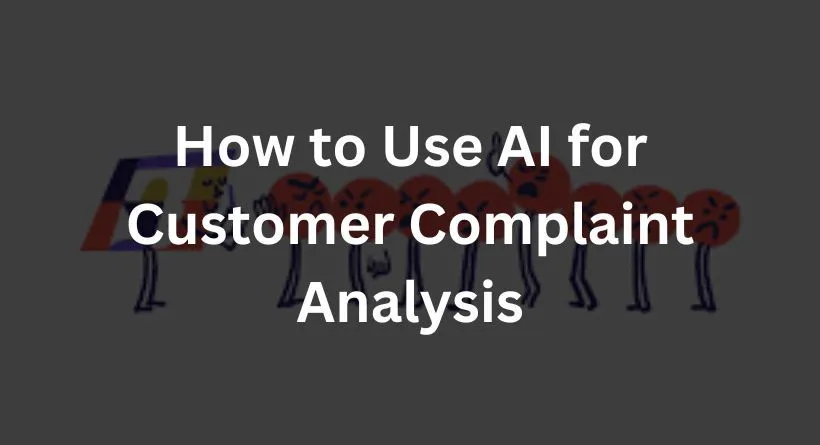
Customer complaints are an integral part of any business. They offer valuable insights into what your customers are experiencing and can help you identify areas that require improvement. However, manually sorting through and analyzing the sheer volume of complaints can be a daunting and time-consuming task. This is where Artificial Intelligence (AI) comes to the rescue. In this article, we will explore how to leverage AI for effective customer complaint analysis.
Understanding Customer Complaints

What Are Customer Complaints?
Customer complaints are expressions of dissatisfaction or issues raised by individuals who have had a negative experience with a product, service, or brand. These complaints can come in various forms, such as emails, social media posts, reviews, or direct communication with customer support.
You may also like reading: Demystifying Conversational AI and its Impact on the Customer Experience
Why Are Customer Complaints Important?
Customer complaints are a goldmine of information. They can help you understand where your business is falling short and what customers expect from your products or services. By addressing complaints effectively, you can improve customer satisfaction and loyalty.
The Role of AI in Customer Complaint Analysis
AI has revolutionized the way businesses handle customer complaints. Here’s how it plays a pivotal role.
Benefits of Using AI
AI offers speed and accuracy in complaint analysis. It can process large volumes of data quickly and identify patterns, sentiments, and keywords that humans might miss. This leads to more efficient issue resolution.
Challenges Addressed by AI
AI can help businesses deal with the “perplexity” of large datasets and the “burstiness” of customer feedback. It can handle an influx of complaints during a crisis or after a product launch, ensuring a consistent and swift response.
Steps to Use AI for Customer Complaint Analysis
To effectively use AI for customer complaint analysis, follow these steps:
Data Collection and Preparation
Gather customer complaints data from various sources, ensuring it’s clean and structured for analysis.
Choosing the Right AI Tools
Select AI tools or platforms that align with your business needs and complaint data types.
Training the AI Model
Train the AI model using historical customer complaints to help it recognize patterns and sentiments.
Implementing the Analysis
Integrate the AI model into your complaint handling process to automate analysis and response.
Real-World Applications
AI-driven complaint analysis is applicable across various industries. Here are a few examples.
E-commerce Industry
E-commerce businesses use AI to analyze customer feedback, helping them enhance the shopping experience and resolve issues promptly.
Healthcare Sector
Healthcare providers leverage AI to process patient complaints, improving patient care and satisfaction.
Banking and Finance
Banks use AI for complaint analysis to address financial concerns and enhance customer trust.
Case Studies
Let’s explore some real-world case studies.
Example 1: An E-commerce Giant
A leading e-commerce company used AI to analyze customer complaints, resulting in a 30% reduction in resolution time and a 20% increase in customer satisfaction.
Example 2: A Leading Healthcare Provider
A prominent healthcare provider implemented AI complaint analysis, leading to a 25% decrease in patient complaints and a 15% improvement in patient ratings.
Example 3: A Major Bank
A major bank adopted AI for complaint analysis, reducing the time to resolve financial disputes by 40% and ensuring compliance with industry regulations.
Advantages of AI-Powered Complaint Analysis
Efficiency and Speed
AI accelerates the complaint analysis process, ensuring that issues are addressed promptly.
Improved Customer Satisfaction
By resolving complaints faster and more accurately, AI boosts customer satisfaction and loyalty.
Challenges and Limitations
AI-powered complaint analysis isn’t without challenges.
Data Privacy Concerns
Handling customer data requires strict compliance with data privacy regulations.
Initial Investment
Implementing AI may require a significant initial investment in technology and training.
Ethical Considerations
Businesses must ensure that AI analysis is fair and unbiased.
Future Trends in AI for Customer Complaint Analysis

The future of AI in complaint analysis holds exciting prospects.
Natural Language Processing (NLP)
NLP will enable AI to understand and respond to customer complaints with even greater accuracy.
Predictive Analytics
AI will become more proactive in identifying and addressing potential issues before they escalate.
Tips for Successful Implementation
To make the most of AI for customer complaint analysis, consider these tips:
Collaborate with AI Experts
Partner with AI experts or consultants who can guide you in selecting the right tools and strategies.
Regularly Update AI Models
AI models should be regularly updated to adapt to changing customer feedback patterns.
Conclusion
Leveraging AI for customer complaint analysis is a game-changer for businesses. It not only streamlines the process but also leads to improved customer satisfaction and loyalty. Embrace the power of AI to stay ahead in the competitive landscape.
FAQs
1: Can AI understand customer emotions in complaints?
Yes, AI can recognize customer sentiments and emotions in complaints, helping businesses address concerns more empathetically.
2: Is AI complaint analysis cost-effective for small businesses?
AI complaint analysis can be tailored to fit the budget and needs of small businesses, making it a cost-effective solution.
3: Are there any industries where AI is not suitable for complaint analysis?
AI can be applied to various industries, but it’s crucial to customize the approach to fit specific requirements.
4: How do AI models ensure data security in complaint analysis?
AI models used for complaint analysis should comply with data security regulations and encryption practices to safeguard customer information.
5: What are the key differences between AI and human complaint analysis?
AI excels in processing large volumes of data quickly and consistently, while human analysis may be more nuanced and empathetic. Combining both approaches often yields the best results.





